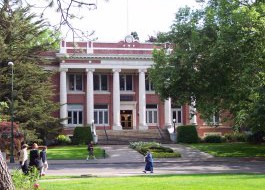 USC Gould School of Law/Facebook
USC Gould School of Law/Facebook
With New York poised to start offering a tuition-free college education for some students, public colleges may be worth a closer look.
New York lawmakers approved the tuition initiative this weekend as part of the state budget. Under the plan — which New York Governor Andrew M. Cuomo proposed in January — the state will supplement aid for in-state residents whose families earn $125,000 or less, providing tuition-free education at all state public two- and four-year colleges.
(Tennessee and Oregon both have programs offering free tuition at two-year community colleges.)
"Today, college is what high school was—it should always be an option even if you can't afford it," Gov. Cuomo said in a statement on the program's inclusion in the state budget. "The Excelsior Scholarship will make college accessible to thousands of working and middle class students and shows the difference that government can make."
The program will phase in over three years, starting in the fall of 2017 for New Yorkers earning up to $100,000 and increasing to $110,000 in 2018. The state expects it to benefit an estimated 940,000 families.
Free tuition doesn't mean zero-cost college, however. Eligible New Yorkers will still be on the hook for room and board and other expenses — and although the number of parents saving for college hit an all-time high last year, the median balance isn't enough to cover even a year of in-state expenses at a public, four-year college.
Among other scholarship requirements, students must also agree to live and work in New York for the same number of years after graduation as they received the scholarship.
But public schools are worth a closer look as you assess which colleges are affordable for your family. Even if you don't qualify for the new scholarship program, New York's average in-state tuition of $7,710 for the 2016-17 academic year makes it the 12th-cheapest nationwide, based on data from the College Board.
If you're out-of-state, public colleges are often less of a bargain, David Levy, editor of Edvisors.com, told CNBC earlier this year. The premium for non-resident students is steep, he said, and state residency requirements can require a student to live locally for more than a year to qualify for the in-state rate.
 Ole Miss Via Flickr
Ole Miss Via Flickr
Per College Board data, public colleges in these 10 states have the least expensive average in-state tuition:
10. Mississippi
Average in-state tuition and fees: $7,410
Five-year change: 23 percent
Average out-of-state tuition and fees: $20,260
9. North Carolina
Average in-state tuition and fees: $7,200
Five-year change: 19 percent
Average out-of-state tuition and fees: $23,750
8. Alaska
Average in-state tuition and fees: $7,130
Five-year change: 23 percent
Average out-of-state tuition and fees: $21,800
7. Idaho
Average in-state tuition and fees: $7,010
Five-year change: 16 percent
Average out-of-state tuition and fees: $21,250
6. Nevada
Average in-state tuition and fees: $6,910
Five-year change: 7 percent
Average out-of-state tuition and fees: $20,720
5. New Mexico
Average in-state tuition and fees: $6,620
Five-year change: 14 percent
Average out-of-state tuition and fees: $19,050
4. Utah
Average in-state tuition and fees: $6,580
Five-year change: 17 percent
Average out-of-state tuition and fees: $19,840
3. Montana
Average in-state tuition and fees: $6,410
Five-year change: 2 percent
Average out-of-state tuition and fees: $22,100
2. Florida
Average in-state tuition and fees: $6,360
Five-year change: 6 percent
Average out-of-state tuition and fees: $21,570
1. Wyoming
Average in-state tuition and fees: $5,060
Five-year change: 15 percent
Average out-of-state tuition and fees: $16,220
This story was originally published by The Fiscal Times.




